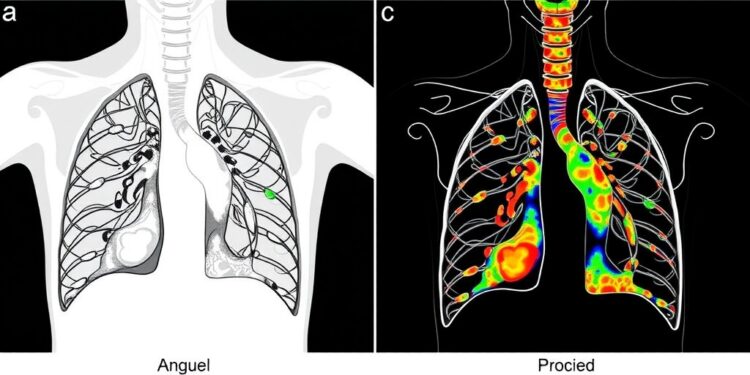
Esophageal cancer remains a significant clinical challenge with complex treatment pathways and often grim prognoses. Surgical intervention, particularly esophagectomy following neoadjuvant chemoradiotherapy, has been established as a potential curative approach for patients with locally advanced disease. However, this surgical procedure is not without its complications. Among the most concerning postoperative issues are pulmonary complications, which can profoundly influence both recovery and overall survival rates post-surgery.
Recent findings from an observational study have illuminated critical factors that may predict these complications. Specifically, metrics derived from morphomic measurements obtained through computed tomography (CT) scans have shown promise in identifying patients at increased risk. This study highlights the crucial role of body composition, focusing on the interplay between increased visceral adipose tissue (VAT) density and decreased skeletal muscle (SM) area. These parameters emerged as significant predictors for post-esophagectomy pulmonary complications, demonstrating how they can be integral in guiding clinical decisions.
The implications of these findings extend far beyond mere academic interest. Preoperative morphomic analysis provides clinicians with an innovative tool to assess risks associated with esophagectomy. By carefully evaluating body composition metrics, healthcare providers can gain deeper insights into a patient’s physiological resilience and potential postoperative trajectory. The ability to predict complications before they arise opens new avenues for patient management, allowing for tailored preoperative interventions that align with individual needs.
In evaluating the study’s findings, the association between decreased skeletal muscle density and poorer overall survival is particularly alarming. Patients with less robust muscle mass not only face heightened risks of postoperative pulmonary complications but may also experience significant declines in overall health outcomes after undergoing esophagectomy. This underscores the necessity of addressing muscle health in preoperative planning, suggesting that initiatives aimed at preserving or enhancing muscle density could yield substantial improvements in patient outcomes.
The study’s insights into the impact of VAT and SM on recovery are particularly relevant in the current medical landscape. With the rising prevalence of obesity, understanding how visceral fat accumulation affects surgical outcomes is critical. Higher VAT density has been linked to inflammation and other systemic complications that could impede recovery, necessitating a comprehensive approach that considers not just the cancer diagnosis but also the overall health and body composition of the patient.
Within this context, prehabilitation emerges as a compelling strategy to enhance surgical outcomes. By developing targeted programs that focus on improving skeletal muscle density and optimizing VAT levels, healthcare teams can proactively manage risk factors in patients slated for esophagectomy. Such programs might include tailored exercise regimens and nutritional interventions, designed to bolster muscular health and reduce fat accumulation in vulnerable populations.
Moreover, the application of morphomics in clinical practice represents a significant shift toward personalized medicine. As healthcare continues to evolve, the ability to leverage data-driven insights from advanced imaging techniques offers a pathway to improved patient-centered care. Implementing routine morphomic analysis could revolutionize preoperative assessments, allowing for a nuanced understanding of individual risk profiles and fostering more informed clinical decision-making.
The publication highlighting these findings, available in the Journal of Thoracic Disease, calls for a paradigm shift in how clinicians approach preoperative evaluations. It challenges conventional wisdom and emphasizes the need for a multidisciplinary approach to esophageal cancer management, integrating insights from nutrition, fitness, and clinical oncology to optimize patient preparedness for surgery.
In conclusion, the role of morphomic predictors in determining postoperative outcomes cannot be overstated. By prioritizing body composition assessments and addressing the nuanced interplay between fat and muscle density, healthcare providers can significantly enhance the quality of care delivered to patients facing esophagectomy. This study lays the foundation for future research, which could delve deeper into the mechanisms underlying these associations, further refining our understanding of risk management in esophageal cancer treatment.
As we move forward, the integration of morphomic analysis into routine clinical practice holds promise not only for reducing complications but ultimately for improving survival rates among esophageal cancer patients. The journey towards better outcomes is paved with data, innovation, and a relentless focus on the unique needs of each patient.
Subject of Research: People
Article Title: Morphomic predictors for post-esophagectomy pulmonary complications and overall survival
News Publication Date: 22-Jan-2025
Web References: http://dx.doi.org/10.21037/jtd-24-1227
References: Chiu CH, Zhang P, Lin J, Chang AC, Ross BE, Enchakalody B, Shah NV, Liu YH, Chao YK, Wang SC. Morphomic predictors for post-esophagectomy pulmonary complications and overall survival. J Thorac Dis 2025;17(1):209-219. doi: 10.21037/jtd-24-1227
Image Credits: N/A
Keywords: Esophageal cancer, clinical studies, cancer patients, cancer treatments, surgery
Tags: body composition and surgical outcomesclinical implications of morphomic analysiscomputed tomography in surgical planningesophageal cancer treatment pathwaysmorphomic predictors in esophageal cancerneoadjuvant chemoradiotherapy effectsoverall survival after esophagectomypost-esophagectomy pulmonary complicationspredictive metrics for postoperative recoverypreoperative risk assessment in esophagectomyskeletal muscle area in cancer patientsvisceral adipose tissue density





